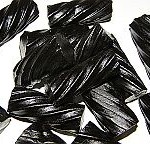Deglycyrhizzinated Licorice Root Extract (DGL) and Duodenal Ulcers
 The root of the licorice plant has been used for thousands of years as a medicinal cure for a variety of ailments. Modern science has revealed that licorice root, indeed, contains some potent compounds that affect the biological systems in both lab animals and man in both beneficial and not so beneficial ways. I started the research for this post thinking it would be a straightforward review of DGL and its ability to positively affect gastric and duodenal ulcers.
The root of the licorice plant has been used for thousands of years as a medicinal cure for a variety of ailments. Modern science has revealed that licorice root, indeed, contains some potent compounds that affect the biological systems in both lab animals and man in both beneficial and not so beneficial ways. I started the research for this post thinking it would be a straightforward review of DGL and its ability to positively affect gastric and duodenal ulcers.
What I ended up with is an intriguing journey into this fascinating plant that spans science, pharmacy and ancient folklore that was anything but straightforward. DGL had for me become a Zen conundrum because it was more about what it didn’t contain that what it did contain. I relied heavily on an excellent review that appeared in the Natural Medicine Review by Tina Kaczor to write this post and urge those wanting a more in depth analysis to peruse it.
Buy DGL Licorice Extract at LEF.org
What Exactly is DGL?
Deglycyrrhizinated Licorice Root Extract or DGL, besides being a dyslexic’s spelling nightmare, is simply the extract in which a compound known as glycyrrhizin has been removed by some proprietary chemical process.
Usually when dealing with a herbal extract we’re accustomed to the supplement label stating that it is guaranteed to contain a specific compound at a specific concentration or “standardized”.
In this case, it is the “not containing” the compound that is guaranteed. However there are no specific concentrations mentioned on any products that I have encountered. If it was standardized, it would state that “Glycyrrhizin standardized to contain not more than…” some specific amount or “99.999% Glycyrrhizin Free” or something along these lines.
This might be important since things like decaffeinated coffee and tea are not completely caffeine-free and some hypersensitive individuals to caffeine can’t tolerate it. Beyond this, the consumer needs to know that the product is being tested by the manufacturer for glycyrrhizin “contamination” in the final product.
The Dark Side of Licorice
A Dutch physician, F. E. Revers, performed two studies on licorice root juice for treatment of gastric and duodenal ulcers in 1946 and 1948, respectively. He found positive results in treating the ulcers in the patients he studied; unfortunately they suffered serious side effects like hypertension and low potassium levels.
In 1950, J. G. Borst and his colleagues astutely determined that the compound glycyrrhizin in the crude licorice juice caused these bad side effects. This inspired Revers to go back and test a deglycyrrhizinated extract and found the side effects disappeared. This is an unfortunate situation because glycyrrhizin has some amazing properties from the antiviral to the antibacterial and also promotes oral health and memory stimulation.
It also was the impetus for pharmaceutical companies to produce glycyrrhizin-like compounds in the lab for gastric and duodenal ulcers but which also carry similar negative side effects. However, since the licorice root is a complex mixture of potentially active compounds like flavonoids and chalcones that may have a positive effect on healing gastric and duodenal ulcers, all hope is not lost.
So Does DGL Work or Not?
There was a spate of studies from 1968 to 1978 on DGL on human ulcer patients by independent researchers. Kazcor in her review article states that the results are hard to interpret due to low patient numbers in some studies and differences in methodologies.
There were some studies that resulted in significant improvements in their subjects with ulcers.
One promising study was done on a European product marketed as Caved-S. Unfortunately while this product contains DGL, it is a witches’ brew of other active compounds like antacids and frangula bark which is a laxative.
When the pharmaceutical companies introduced their H2 blocking drugs like Tagamet and Zantac in the the late 70’s and early 80’s the focus for ulcer treatment shifted away from DGL.
Then when H. pylori was recognized as a causative bacterial agent in ulcers the focus shifted once again; this time to antibiotic treatment.
Buy DGL Licorice Extract at LEF.org
How to Supplement with DGL
DGL comes in chewable tablets since it is suggested that saliva needs to be mixed with the active components in order for proper activation and absorption. I could find no scientific research to back this up using an Internet query. However, I like the idea of the oral cavity being exposed to the compounds in DGL because it may have a positive effect on oral health by healing mouth sores and killing oral bacteria.
Be forewarned though, that if you don’t like the taste of licorice in a chalky form then you’re going to have a problem. I personally like the taste of these chewable tablets since I like the taste of licorice.
Tablets typically come in 380 mg doses. The studies with DGL used from 2,280 mg to 4,500 mg daily. The regimen in these studies was typically to chew 2 tablets between meals three times a day.

No Comments